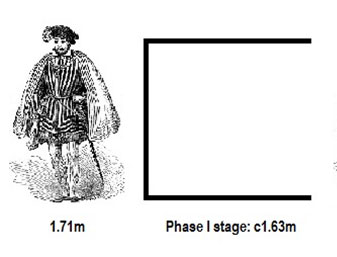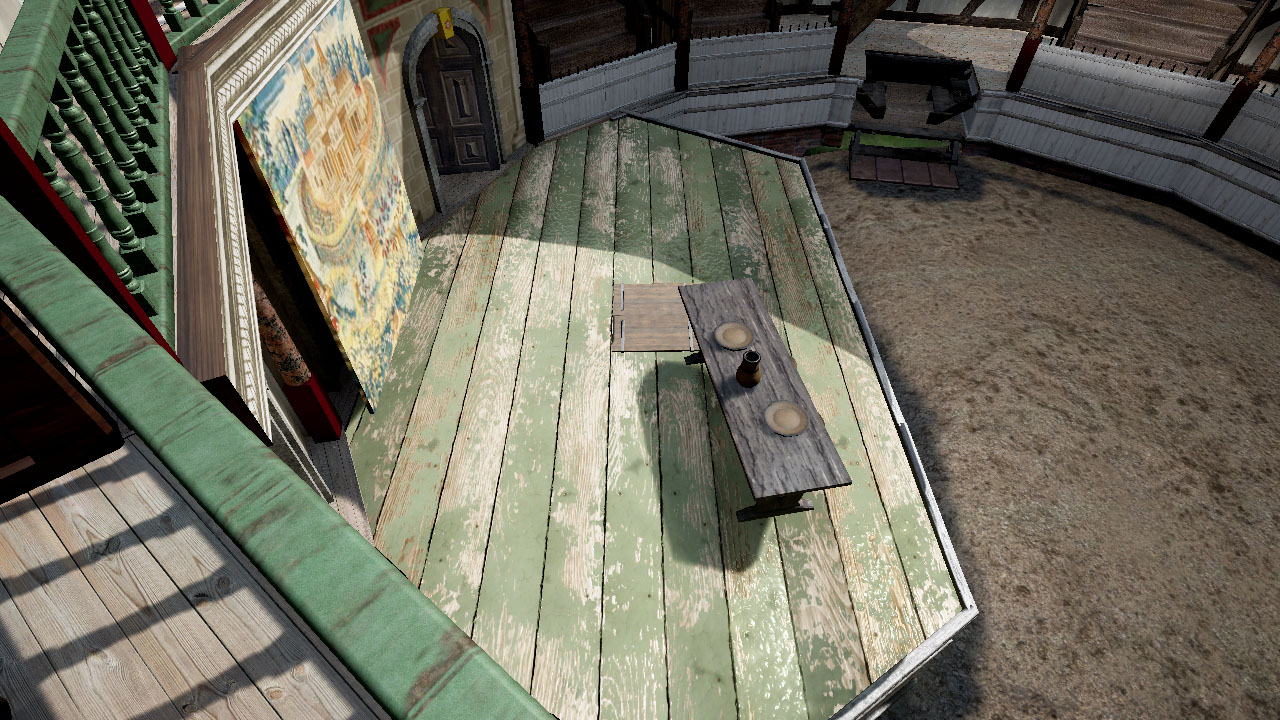Excavations found that underneath the stage was a screed surface with a slight slope southward towards the front of the stage. It stopped short of the front, however, suggesting either that it had been cut by the stage front wall or eroded away. This would have created an under-stage area that could have been used for storage or for multitude of other purposes, suggest Bowsher and Miller.153
If the height of the stage floor was built at the same height of the lower gallery floor, as would seem sensible from an architectural perspective, the room below stage would have been generous and allowed for a person of average height in the seventeenth century—1.17m tall—to pass underneath the stage with reasonable ease.

sixteenth century (1.71m) and the under stage height
of the Rose, Phase I (c. 1.63m)
However, the excavations also noted a thin organic layer had accumulated over the plaster surface underneath the stage at the early Rose, which may suggest there was limited access to and use of the under-stage area.
Gurr and Orrell note that the mortar surface had been worn away in two places ‘to reveal short sections of timber, one with a mortice cut in it, in line with the stage front and two or three feet behind it,’ which they speculate ‘may be part of an even earlier stage, or more likely part of the underpropping of the original timber stage, perhaps even part of the trap machinery.’154
Wickham’s argument is that trap doors were not required by plays performed at the Rose.155 However, Gurr questions this: ‘A trapdoor there must have been in 1587, though the evidence about it is not precise unless we take seriously the mortaring of the two under-stage areas found by the archaeologists.’156
Recent scholarship has started to reconsider the long-held assumption that purpose built Tudor playhouses necessarily had a trap.157 Mark Hutchings points out that visual evidence to support this idea is dubious; it has been argued that the title-page illustration for Richards’ Messalina may offer visual evidence of a stage trap, although the sketch of the Swan playhouse does not appear to feature one, and neither contract for the Fortune (1600) or the Hope (1614) playhouses mentions a trap but say little about the design of the stage. It is possible that Henslowe and Cholmley may not have included a trap at the Rose in 1587 but included one with the later renovations by Henslowe, although no specific mention of the provision of a trap is included in his accounts from 1592. Little is known of the plays before 1592 when Henslowe started recording play receipts as part of his accounts. If Christopher Marlowe’s Doctor Faustus were an early Rose play and if the existence of a stage property of ‘Hell’s Mouth’ was associated with it, a stage door rather than a trap may have served well for its location as the side of the stage had done on platform stages since mediaeval times.158
Whilst a trap may have served as a locus from which devils and ghosts might emerge from the underworld, it is not an absolute, and other entrances would have sufficed just as well.Whilst a lack of evidence of a trap at the early Rose doesn’t necessarily mean there wasn’t one, no trap door has been added to the Phase I model.
[153] Bowsher and Miller, The Rose and the Globe, 47.
[154] Gurr and Orrell, ‘What the Rose can tell us,’ 425.
[155] Bowsher, The Rose Theatre, 67; see ‘Notes on the Staging of Marlowe’s plays,’ in Glynne Wickham, Shakespeare’s Dramatic Heritage (London: Routledge & Kegan Paul, 1969), 125–26; and Wickham ‘“Heavens”, Machinery, and pillars,’ 4.
[156] Gurr, ‘The Rose repertory,’ 129.
[157] This notion is supported by Mark Hutchings, Reading University, who was generous enough to share his pre-publication article, ‘Titus Andronicus at the Rose and Newington Butts,’ based on a paper presented at a symposium on ‘Henslowe’s Rose’ hosted by Shakespeare’s Globe, Saturday, 21 May 2016, on ‘The trap at the Rose.’ It is his contention that ‘the Rose Phase I probably did not have a trap but that one was added when Henslowe made his renovations in 1592’ (personal correspondence by email, 3 July 2017).
[158] Christopher Marlowe, Tragical History of the Life and Death of Doctor Faustus (London: John Wright, 1616), STC 2nd 17432. Henslowe records numerous performances of Marlowe’s play between September 1594 – October 1597 (Ibid, 24-28, 30-31, 34, 36, 47, 54-55, 60). Henslowe’s inventory of props and costumes for the Lord Admiral’s Men at the Rose on 10 March 1598 (reproduced in Foakes, 319) includes ‘i Hell mought’ (one hell mouth) along with other properties and items of clothing required for staging Dr Faustus.
